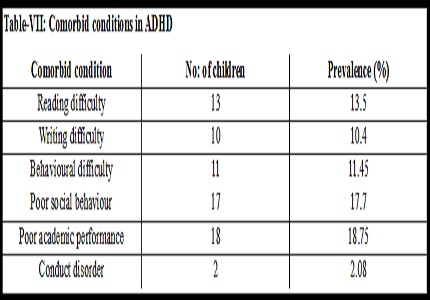Comorbidity & socioeconomic status associated with attention deficit hyperactive disorder
Abstract
Aims & Objectives: (1) To find out the prevalence of ADHD in urban primary school children (2)To find out the presence of any co-morbid disorders associated with ADHD.
Settings and design: This is a cross sectional study of school children selected from 15 different Govt. Schools nearby Govt. Royapettah Hospital, attached to Govt. Kilpauk medical college, Chennai.
Material & Methods: 1000 children aged between 5 and 11 years were randomly selected from 15 different schools in Chennai. The presence of ADHD was then assessed by using Vanderbilt assessment scale Teacher’s version by their class teachers. Those children screened positive were verified and reassessed for the presence of any comorbid factors by using Child Behavioural Checklist (CBCL) scale. All children screened positive were subjected to psychiatrist evaluation.
Results: The prevalence of ADHD among urban primary school children in Chennai, Tamilnadu was found to be 9.67%. Poor academic performance was the most common associated comorbid condition (18.75%), followed by poor social behaviour (17.7%).
Conclusion: The present study shows Poor academic performance was the most common associated comorbid conditions, followed by poor social behaviour.
Downloads
References
2. Hallowell, E.M. and J.J. Ratey. Driven to Distraction: Recognizing and Coping with Attention Deficit Disorder from Childhood through Adulthood. New York: Simon and Schuster, 1994.
3. Singhi P, Malhi P. Attention deficit hyper-activity disorder in school aged children: Approach and principles of management. Indian Pediatr 1998; 35: 989-999.
4. Levin FR, Kleber HD. Attention-deficit hyperactivity disorder and substance abuse: relationships and implications for treatment. Harv Rev Psychiatry. 1995 Jan-Feb;2(5):246-58. [PubMed]
5. Tannock, R. and Schachar, R. (1996). Executive dysfunction as an underlying mechanism of behavior and language problems in attention deficit hyperactivity disorder. In Language, learning, and behaviourdisorders: developmental, biological, and clinical perspectives (ed. J.H. Beitchman, N. Cohen, M.M. Konstantareas, and R. Tannock), pp. 128– 55. Cambridge University Press, New York.
6. Szatmari P,OffordDR,Boyle MH. Ontario Child Health Study:Prevalence of attention deficit disorder with hyperactivity. J Child Psychol Psychiatry 1989;30:219-30. [PubMed]
7. Vanderbilt assessment scale –teacher’s version :http://www.jeffersandmann. com/client_ files/file/JMA_ Vanderbilt-Teacher-Informant.pdf
8. Child Behaviour Checklist (CBCL) Scale: http://www.aseba.org/forms/schoolagebcl.pdf
9. Scahill L, Schwab‑Stone M, Merikangas KR, Leckmaz JF, Zhang H, Kasl S. Psychosocial and clinical correlates of ADHD in a community sample of school‑age children. J Am Acad Child Adolesc Psychiatry 1999;38:976‑84. [PubMed]
10. Bhatia MS, Nigam VR, Bohra N et al. Attention deficit disorder with hyperactivity among paediatric outpatients. J Child Psychol Psychiatry 1991;32:297-306
11. Bhatia MS, Choudhary S, Sidana A. Attention deficit hyperactivity disorder among psychiatric outpatients. Indian Pediatr 1999; 36: 583-587.
12. Milberger, S., Biederman, J., Faraone, S.V., Chen, L., and Jones, J. (1996). Is maternal smoking during pregnancy a risk factor for attention deficit hyperactivity disorder in children? American Journal of Psychiatry, 153, 1138–42. [PubMed]
13. Streissguth AP, Barr HM, Sampson PD, Bookstein FLPrenatal alcohol and offspring development: the first fourteen years.Drug Alcohol Depend. 1994 Oct;36(2):89-99.
14. Gadow KD, Nolan EE, Litcher L et al. Comparison of attention deficit/hyperactivity disorder symptom subtypes in Ukrainian school children. J Am Acad Child Adolesc Psychiatry 2000;39:1520-7.
15. Pineda D, Ardila A, Rosselli M et al. Prevalence of attention deficit/hyperactivity disorder symptoms in 4- to 17-year-old children in the general population. J Abnorm Child Psychol1999;27:455-62. [PubMed]
16. Pineda DA, Lopera F, Henao GC, Palacio JD, Castellanos FX; Grupo de InvestigaciónFundema. [Confirmation of the high prevalence of attention deficit disorder in a Colombian community]. Rev Neurol. 2001 Feb 1-15;32(3):217-22.
17. Nolan EE, Gadow KD, Sprafkin J. Teacher reports of DSM-IV ADHD, ODD, and CD symptoms in schoolchildren. J Am Acad Child Adolesc Psychiatry. 2001 Feb;40(2):241-9. [PubMed]
18. Pingali S. Sunderajan J. A study of comorbidities in attention deficit hyperactivity disorder: a retrospective analysis of case records. AP J Psychol Med 2014; 15(2):206-10
19. Palaniappan P, Seshadri S,Giriraji SC,Srinath S. Pattern of comorbidities in Indian children and adolescents with attention deficit hyperactivity disorder.European Psychiatry 2013;28:1.
20. Taylor, E., Chadwick, O., Heptinstall, E., and Danckaerts, M. Hyperactivity and conduct problems as risk factors for adolescent development. Journal of the American Academy of Child andAdolescent Psychiatry, 1995;35, 1213–26.

Copyright (c) 2018 Author (s). Published by Siddharth Health Research and Social Welfare Society

This work is licensed under a Creative Commons Attribution 4.0 International License.


 OAI - Open Archives Initiative
OAI - Open Archives Initiative


